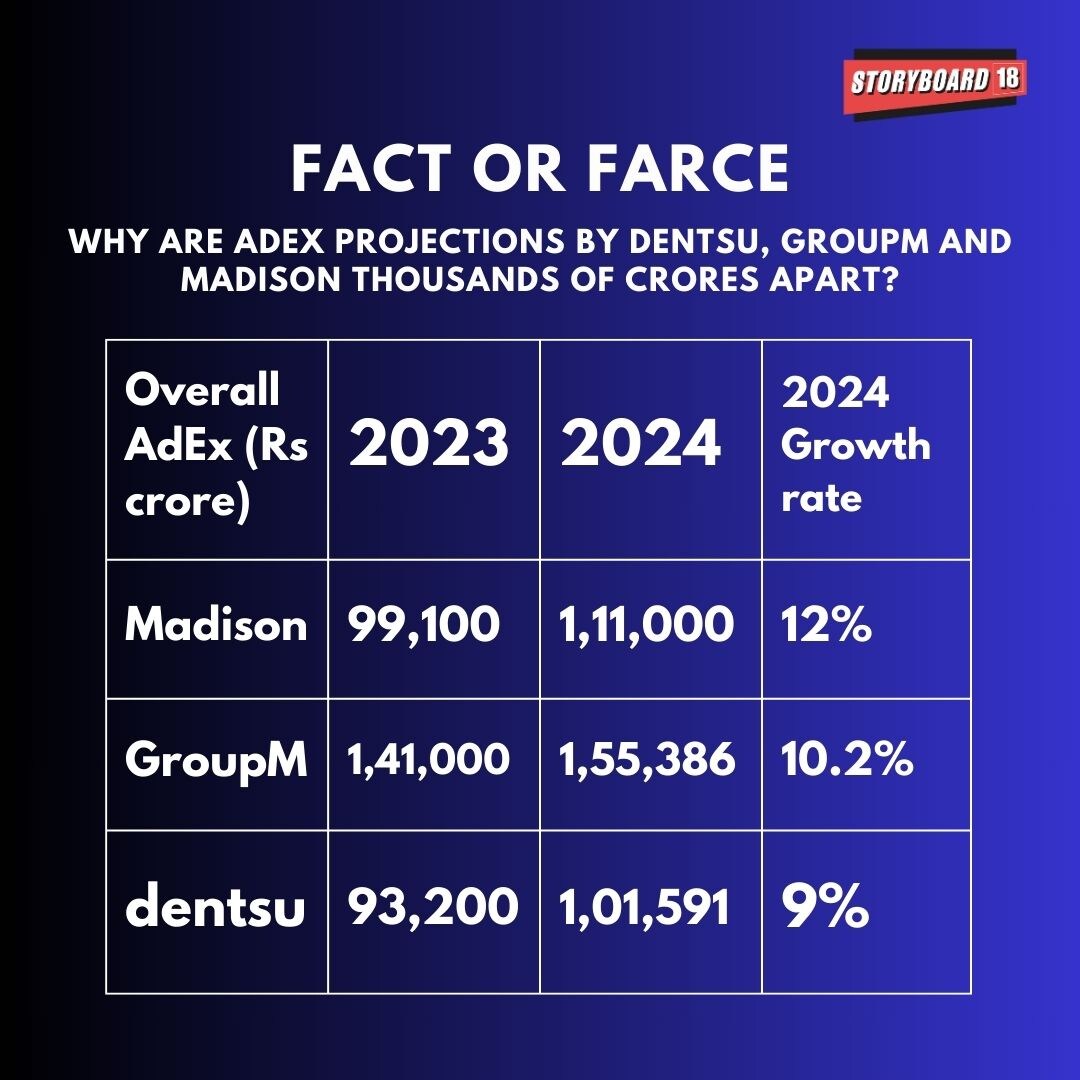Fact or farce: Why are AdEx projections by Dentsu, GroupM and Madison thousands
Top advertisers said that the divergence in projections is due to differences in digital Adex numbers and agencies' own vantage and advantage


Advertisers are inundated with ad expenditure data. But the data lacks standardisation, leaving advertisers dazed, confused and, in some cases, increasingly indifferent to agencies" wildly varying AdEx projections. In the last two weeks, at least three top media agencies released their own advertising reports, each offering a unique and contradictory view of the Indian ad landscape.
Sample this. According to the latest dentsu advertising report, the AdEx is expected to touch Rs. 1,01,591 crore in 2024 with digital contributing Rs 50,857 crore. WPP-owned media investments powerhouse GroupM on the other hand said, in its ‘This Year Next Year’ report, the overall ad revenue is expected to reach Rs 1,55,386 crore in 2024 with digital contribution of Rs 88,502 crores. Homegrown media agency Madison said the year will end with AdEx touching Rs 1,11,110 crore with digital"s contribution at Rs 46,565 crore.
The difference in these projections is not a couple of thousands but thousands of crores. To be precise, the gap between Dentsu and GroupM AdEx projections is Rs 53,795 crore.
What are we missing?
“To be honest, these reports are a bit of data and a bit of hope," said the marketing head of a popular Indian personal care brand, also a heavyweight advertiser.
“While reports offer data, they are often based on assumptions and past data about industry performance and advertiser spending. These are shaky foundations in today’s ad landscape. Byju’s and Paytm are the perfect examples to explain this pattern. There are innumerable brands like these that start big and fade out gradually," the marketer said.
Clearly, before fading out they make their way to AdEx reports and swell up projections.
However, discrepancies are not limited to projections, which one might excuse due to their reliance on aggregations and assumptions.
Year-on-year AdEx figures also vary significantly and it is further amplified by contrasting projections and achievements even within the same agency.
In the beginning of last year, Japanese major dentsu"s India arm said it expected the advertising industry to touch Rs 98,363 crore by the end of 2023 at a growth rate of 14.7 percent. But 2023 ended at Rs 93,166 at a growth rate of 8.6 percent. The difference in projections was Rs 5197 crore and 6.1 percent.
Similarly, GroupM’s report for the year said that 2023 closed at Rs1,40,963 crore. In the beginning of 2023 they said 2023 would close at Rs 1,46,450 crore.

As per Madison, 2023 closed at Rs. 99,038 crore.
Finding reliable data on AdEx is finding a needle in a haystack.
So what are marketers doing?
Some said, they are focused on internal research backed data for a more grounded perspective.
Shashank Srivastava, senior executive officer, marketing and sales at Maruti Suzuki India Limited shared his honest opinion.
“There are three such reports in the market today but what we can clearly see is that the majority of divergence in the forecasted numbers is due to differences in digital AdEx numbers," he said.
“Digital AdEx numbers are usually opaque in nature as there is no industry body like BARC (TV) which releases data publicly. Further, the major share of digital AdEx is controlled by Google and Meta who again don"t publicly share their AdEx numbers. Hence, all the media houses use different approximations to arrive at digital AdEx numbers," he added.
According to Srivastava, there is a long list of very small mom and pop retailers who use digital advertising services only since they don"t have resources to create and run bigger campaigns. This long tail again makes digital AdEx forecasts harder to predict accurately. All these reasons cause divergences in their assessment of digital AdEx numbers published by different media reports.
“We are further examining the details," he said.
Another marketer had an interesting perspective on the differences.
“The vast difference in AdEx forecasts highlights the limitations of these reports. Imagine peeking through a keyhole, in this case Dentsu’s digital focus versus gazing from a balcony which is GroupM"s broader view. The truth likely lies somewhere in between," said one of the country’s largest advertisers.
However, data discrepancies are not killing the joy for advertisers. 2024 is expected to boost the overall AdEx with general elections around the corner. All three agencies project a 2024 AdEx boost due to general elections. Divided by numbers, united by facts, some might say.
First Published: Feb 16, 2024, 18:20
Subscribe Now